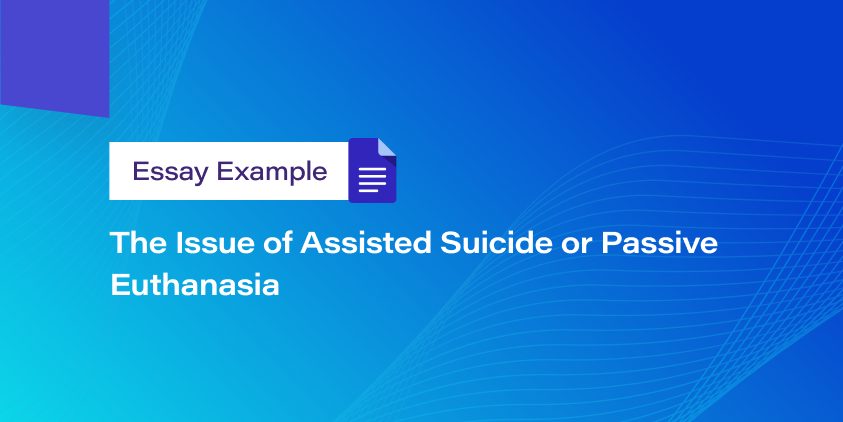The Issue of Assisted Suicide or Passive Euthanasia

The issue of Assisted Suicide or Passive Euthanasia raises sharp and controversial debate among the US population and other classes of people worldwide. Some people support the idea of legalizing Assisted Suicide, while other people sharply object to this move. This issue is local to the United States and affects most other countries. Coverage of this topic reveals the reasons for and against this controversial debate. As a result, one can objectively come up with an informed judgment as to whether Assisted suicide should be legalized. This issue attracts scholarly attention since it affects the social being of modern society, threatening to cause a social rift, and scholars are obliged to shed some light on it for the good of the entire society.
Background Information
Medical practitioners define Assisted Suicide or Passive Euthanasia as hastening someone’s death by modifying some form of support and allowing nature to pursue its course. This is carried out on patients having terminal illnesses to hasten the occurrence of natural death. This is achieved by disconnecting respirators, halting medication, failing to renew and depriving the patient of water and food so that the patient dehydrates and starves to death. In other cases, the patient gets high doses of the pain-controlling morphine without regard to the likelihood of this drug stopping respiration earlier and causing death.
In 1999, the California legislature drafted a bill to legalize assisted suicide. However, the Disability Rights Education and Rights Fund (DREDF) joined ten other disability organizations to oppose this move. As a result, this bill got defeated. The coalition opposing this bill comprised workers, poor people, disability rights organizations, physicians, health care workers, catholic, hospice organizations, and right-to-life organizations. The opposition to the legalization of assisted suicide is mischaracterized as composed of religious, although present-day opposition comes from people who possess a strong belief in progressive politics.
The proponents of this move base their argument on the fact that assisted suicide is conducted out of compassion to alleviate the patient from torture and pain. This, they argue, assists the patient quietly and comfortably in attaining a state of eternal rest. Regarding financial implications, assisted suicide costs from $35 to $50, far cheaper than trying to handle a terminal ailment.
Presently, several organizations bring their efforts together to advocate for the rights of the people in a bid to stop the legalization of this law. Such groups include the Association of Programs for Rural Independent Living (APRIL) American Association for People with Disability (AAPD).
Proponents and Opponents of the Issue
This essay focuses on capturing the reasons from either side of the debate. The proponents’ reasons, as well as the opponents’ reasons, are subject to address. This essay sample aims to share reasons clearly and concisely so that the audience takes an informed and realistic stance.
Proponents’ Position
The American Civil Liberties Union argued in 1996 that it is the right of a competent terminally ill patient to avoid unbearable pain and welcome a timely and dignified death. They claim that this move enjoys historical backing under ordered liberty. The union argues that the court needs to enforce this law regarding human dignity. Further, a 1998 study in the New England Journal of Medicine estimates the savings of allowing people to die before their last month of life at $627 million.
Marcia Angel, a senior lecturer at Harvard Medical School, argues in her July 2006 article “The Quality of Mercy” that there is no right way to die. She further states that there is no schism between advocates for sound palliative care and those for hastening death through a physician’s help. According to her, it is insensitive and inappropriate to let dying patients undergo tremendous suffering, irrespective of their wishes.
Barbara Coombs Lee, President of Compassion and Choices, in her exclusive testimony before the US House Subcommittee, blames medical science for conquering gentle and peaceful deaths while neglecting the humiliating and agonizing of walking relentlessly downhill. This suffering, she states, is not trivial, and nothing is addressing it in medical science. She ends by saying that with knowledge of certain rare and desperate cases advocating for compassionate responses in assisted death, the democratic heritage calls for legal consistency with that knowledge.
Opponent’s Position
DREDF argues that the move to legalize assisted suicide is set to benefit a few and heart majority. According to DREDF, legalizing assisted suicide only benefits the affluent, whites possessing good health insurance coverage. The underprivileged, on the other hand, get exposed to a significant risk of harm.
Wesley Smith, an anti-euthanasia activist, in his 1997 book Forced Exit: The Slippery Slope From Assisted Suicide to Legalized Murder, insists that equality of human life ethic dictates considering every one of equity moral value, and it is society’s priority to uphold this. Legalizing assisted suicide means running away from challenges instead of facing them.
This essay, therefore, addresses the various dimensions of this heated debate on this controversial topic. Once addressed, the US citizens shall form an informed stance on the topic.
📎 References:
1. Dworkin, G., Frey, R. G., & Bok, S. (1998). Euthanasia and Physician-Assisted Suicide. New York: Cambridge University Press.
2. Emanuel, L. L. (1998). Regulating How We Die: The Ethical, Medical, and Legal Issues Surrounding Physician-Assisted Suicide. Harvard: Harvard University Press.
3. Golden, M. (2011). Why Assisted Suicide Must Not Be Legalized. Retrieved Feb 07, 2013.
4. Gorsuch, N. M. (2009). The Future of Assisted Suicide and Euthanasia. New York: Princeton University Press.
5. Paterson, C. (2008). Assisted Suicide and Euthanasia: A Natural Law Ethics Approach. Chicago: Ashgate Publishing, Ltd.
6. Whitbourne, S. K., & Whitbourne, S. B. (2010). Adult Development and Aging: Biopsychosocial Perspectives. Chicago: John Wiley & Sons.
